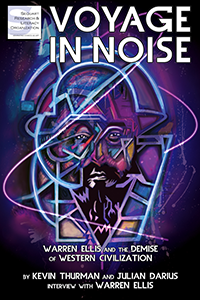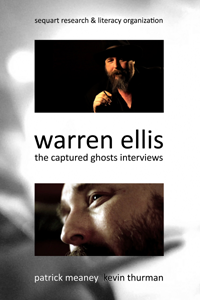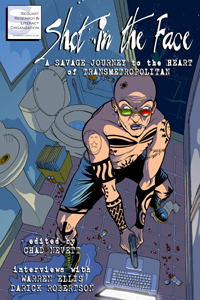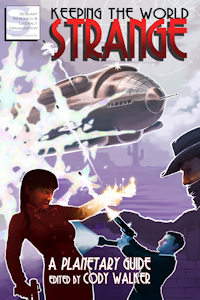Last time, we discussed how Warren Ellis is a realist, and we contrasted this with the views of Grant Morrison.
These two modes correlate strongly with two different modes of super-hero stories. Revisionism, most frequently connected with Watchmen (by Alan Moore and Dave Gibbons, 1986-1987) and The Dark Knight Returns (by Frank Miller and Klaus Janson, 1986), followed on 1970s reforms towards realism within the genre. Revisionism applied real-world psychologies to super-heroes, and the results weren’t always pretty; violence and psychosis were often the result. This move towards realism was part of a larger attempt to make the super-hero genre more literary (since realistic fiction is often thought to be “higher” than genre work), and revisionist comics often experimented with new formats and narrative techniques. By the early 1990s, revisionism had become the dominant mode within super-hero comics, and the results often preserved the violence without revisionism’s intelligence.
In response, some creators began rebelling against revisionism, seeking to restore the sense of wonder and joy they felt had been lost. After Marvels (by Kurt Busiek and Alex Ross, 1994), this counter-reformation coalesced, through works like Astro City (by Kurt Busiek and Brent Anderson, beginning in 1995), into a movement of its own. Reconstructionism eschewed realism, while keeping much of revisionism’s literary intelligence. A key player in proving this mode’s commercial viability was Grant Morrison’s JLA (#1, Jan 1997), which soon became DC’s top-selling title. By the turn of the millennium, reconstructionism had become the dominant mode in American super-hero comics. And just as revisionism led to many pale imitators, so too has reconstructionism, to the point that most super-hero comics have embraced the glossy “fun” of super-powers while often exhibiting hostility not only to realism but to the rudiments of narrative logic.
 Ellis, with his concern for realism, spent most of the 1990s ignoring reconstructionism.[1] A year after Marvels announced this new mode but before it became dominant, Marvel Comics allowed Ellis to script a companion piece to Marvels, entitled Ruins (1995). As its name suggests, it staked out the complete opposite sensibility, eviscerating Marvel’s super-heroes by presenting a parallel universe in which they were destroyed by their own powers, rather than becoming glistening wonders. Fans aware of Ellis’s public laments that the medium of comic books is so dominated by super-heroes might read Ruins as an attack upon the genre, and it’s certainly dark and satirical. But it’s also a revisionist manifesto, demonstrating how rapidly bright and happy super-hero stories would collapse under the application of even the most obvious of real-world physics and politics. This thesis is not unlike pointing out how, in nature, most mutations result in an organism’s inviability, rather than, say, the ability to shoot fire from one’s hands without being burned (which is actually two separate super-powers).
Ellis, with his concern for realism, spent most of the 1990s ignoring reconstructionism.[1] A year after Marvels announced this new mode but before it became dominant, Marvel Comics allowed Ellis to script a companion piece to Marvels, entitled Ruins (1995). As its name suggests, it staked out the complete opposite sensibility, eviscerating Marvel’s super-heroes by presenting a parallel universe in which they were destroyed by their own powers, rather than becoming glistening wonders. Fans aware of Ellis’s public laments that the medium of comic books is so dominated by super-heroes might read Ruins as an attack upon the genre, and it’s certainly dark and satirical. But it’s also a revisionist manifesto, demonstrating how rapidly bright and happy super-hero stories would collapse under the application of even the most obvious of real-world physics and politics. This thesis is not unlike pointing out how, in nature, most mutations result in an organism’s inviability, rather than, say, the ability to shoot fire from one’s hands without being burned (which is actually two separate super-powers).
At the time, the success of Marvels could seem like a fad, and many did attribute its success more to Alex Ross’s beautiful painted artwork than to the series’s optimistic outlook or its unapologetic embrace of the unrealistic elements of the genre (and of Marvel history). By 1997, no one could be naïve, and Ruins looked like an odd throwback to the revisionism of the 1980s – one that failed to understand that Marvels had been a portent of things to come.
During the rise of reconstructionism, Ellis kept writing in a revisionist mode. Consider Stormwatch, which he wrote for WildStorm (then published through Image Comics) from 1996 (Stormwatch Vol. 1 #37, July 1996) to 1998 (Stormwatch Vol. 2 #11, Sept 1998). It’s filled with political conspiracies, psychotic super-heroes, and social themes – as well as a lot of stereotypically dark revisionist violence. As a whole, it’s uneven (and suffers from artistic changes), but it’s got several moments of stirring intelligence. DV8, which Ellis also wrote for WildStorm during these years (#1-8, Sept 1996 – June 1997), has a similar tone. It’s a brilliant, revisionist satire of super-hero teen titles, filled with sex and selfishness and some real personal desperation – all of which are a lot more realistic than most super-hero depictions of teens.
 WildStorm gave Ellis considerable freedom to write super-heroes how he wished, and this is what Ellis came up with: titles that fit squarely within the revisionist mold. WildStorm liked the work and supported him, but by 1998 wasn’t making substantial revenue from it. Ellis recounts (in Warren Ellis: Captured Ghosts and elsewhere) that he hadn’t been aware of this and didn’t feel good about it. So he examined what super-hero readers seemed to want, such as Morrison’s reconstructionist JLA, and set about to imitate and improve upon it. The result was Planetary (#1, April 1999) and The Authority (#1, May 1999), both for WildStorm. Ellis’s series proposal for Planetary is especially clear about his desire to respond to the reconstructionist trend and his need to restrain some of his own inclinations to achieve this. He would later describe The Authority, which was a re-envisioning of Stormwatch, as Stormwatch with its intelligence removed. And though this may have been flippant or deliberately provocative, it speaks volumes about Ellis’s personal inclination towards revisionism.
WildStorm gave Ellis considerable freedom to write super-heroes how he wished, and this is what Ellis came up with: titles that fit squarely within the revisionist mold. WildStorm liked the work and supported him, but by 1998 wasn’t making substantial revenue from it. Ellis recounts (in Warren Ellis: Captured Ghosts and elsewhere) that he hadn’t been aware of this and didn’t feel good about it. So he examined what super-hero readers seemed to want, such as Morrison’s reconstructionist JLA, and set about to imitate and improve upon it. The result was Planetary (#1, April 1999) and The Authority (#1, May 1999), both for WildStorm. Ellis’s series proposal for Planetary is especially clear about his desire to respond to the reconstructionist trend and his need to restrain some of his own inclinations to achieve this. He would later describe The Authority, which was a re-envisioning of Stormwatch, as Stormwatch with its intelligence removed. And though this may have been flippant or deliberately provocative, it speaks volumes about Ellis’s personal inclination towards revisionism.
Both Planetary and The Authority became huge successes and were written to give their gorgeous super-hero artwork (by John Cassaday and Bryan Hitch, respectively) room to shine. While Planetary focused on the wonder of the fantastic, The Authority focused on huge-scale battles, a format soon termed “widescreen” super-heroics. In this, they took JLA’s sense of spectacle to new heights. Ellis kept several elements common to revisionism, such as government conspiracies, corrupted super-heroes, extreme violence, and some realistic twists on super-powers. But he’d shown that he could not only adapt himself to the popular reconstructionist trend but reinvigorate it. And it’s telling that these two series are among his biggest mainstream successes.
 While not a super-hero work, Transmetropolitan (illustrated by Darick Robertson) demonstrates many of revisionism’s concerns. Begun during his Stormwatch years, Transmetropolitan (#1, Sept 1997) often featured the kind of social critiques and political concerns common to revisionism. With a journalist as its protagonist, Transmetropolitan was a perfect vehicle for such investigations, with Spider Jerusalem frequently forcing readers to look at reality. Remarkably, despite the series’s futuristic setting, it’s focused not on the stars but on the streets, on characters and the social forces that affect them. The series continued in this same vein, right alongside Ellis’s reconstructionist successes (concluding with #60, Nov 2002).
While not a super-hero work, Transmetropolitan (illustrated by Darick Robertson) demonstrates many of revisionism’s concerns. Begun during his Stormwatch years, Transmetropolitan (#1, Sept 1997) often featured the kind of social critiques and political concerns common to revisionism. With a journalist as its protagonist, Transmetropolitan was a perfect vehicle for such investigations, with Spider Jerusalem frequently forcing readers to look at reality. Remarkably, despite the series’s futuristic setting, it’s focused not on the stars but on the streets, on characters and the social forces that affect them. The series continued in this same vein, right alongside Ellis’s reconstructionist successes (concluding with #60, Nov 2002).
An even clearer illustration of Ellis’s realistic approach may be seen in his run on Hellblazer (#134-143, Feb-Dec 1999). Hellblazer had been launched (#1, Jan 1988) in revisionism’s heyday, and it brought much of the same intelligence and realism to supernatural horror that revisionism had brought to super-heroes. Magic in Hellblazer was rarely easy, and many stories explored social or psychological themes, or featured no magic at all. But the title was populated by demons, including even a version of the Devil himself, and arguably became more exaggerated over the years. Ellis didn’t take the series back to its slightly more realistic, socially-conscious, revisionism-influenced roots; instead, he overshot by a wide margin, virtually stripping magic from the title altogether and frequently focusing on social ills. Demons, said Ellis, weren’t scary to him; the terrible things human do to each other was.
Begun almost simultaneously with Planetary and The Authority, Ellis’s Hellblazer couldn’t have been more different. While brilliant work, it wouldn’t last: in the wake of the Columbine school shooting, DC censored what would have been an issue depicting a similar shooting (scheduled for Hellblazer #144), and Ellis walked. How’s that for realistic?
The success of Planetary and The Authority, while somewhat against the writer’s natural grain, launched Ellis into the top ranks of American super-hero writers, while high-profile non-super-hero work like Transmetropolitan and Hellblazer lent him added credibility. After helming an unsuccessful revamp of auxiliary X-Men titles (a project termed “Counter-X”) in 2000, Ellis largely avoided super-hero titles for a few years. But his other work during this time shows the same concern for realism.
 Take, for example, Ellis’s celebrated Ministry of Space (#1-3, Apr 2001 – Apr 2004), published by Image Comics and beautifully illustrated by Chris Weston. Ministry of Space was harder sci-fi than Transmetropolitan, telling an alternate-history story in which Britain got to German rocket scientists before the United States, leading to Britain taking the lead in the space race. One of Ellis’s finest works, the content of Ministry of Space would have been at home among the most serious of realistic sci-fi novels. If it’s about the fantastic, it’s only about how humans are capable of fantastic things – of even reaching for the stars. It’s the reverse of Ellis’s argument about horror: Ministry of Space argues that the real wonders aren’t super-heroes but the very real and fantastic things human beings can do. They can even reach for the stars, if only they’d look at reality and decide to do so.
Take, for example, Ellis’s celebrated Ministry of Space (#1-3, Apr 2001 – Apr 2004), published by Image Comics and beautifully illustrated by Chris Weston. Ministry of Space was harder sci-fi than Transmetropolitan, telling an alternate-history story in which Britain got to German rocket scientists before the United States, leading to Britain taking the lead in the space race. One of Ellis’s finest works, the content of Ministry of Space would have been at home among the most serious of realistic sci-fi novels. If it’s about the fantastic, it’s only about how humans are capable of fantastic things – of even reaching for the stars. It’s the reverse of Ellis’s argument about horror: Ministry of Space argues that the real wonders aren’t super-heroes but the very real and fantastic things human beings can do. They can even reach for the stars, if only they’d look at reality and decide to do so.
While very different, Strange Kiss (#1-3, Nov 1999 – Jan 2000), published by Avatar Press and illustrated by Mike Wolfer, nonetheless infuses genre content with violent realism. The series stars William Gravel, a “combat magician,” thus combining the supernatural and military genres. In this, the series might be classified as slipstream – a type of sci-fi combining elements of the fantastic with a real-world focus. The result is violent, dark, and something that would be classified as revisionism, were it identified as a super-hero work. That Ellis took this work to Avatar, then known largely for its sexploitation comics, was also an important gesture, signaling his creative independence as a writer and his willingness to engage in adult material.
Ellis would continue work for Avatar. Of particular note is the first of many follow-ups to Strange Kiss: Stranger Kisses (#1-3, Dec 2000 – Feb 2001, also with Mike Wolfer), which explored snuff films and body manipulation, and included close-up imagery of surgically implanted genitalia, sometimes taking imaginative shapes. Both in terms of its content and what it represented for his career, with Stranger Kisses, Ellis (arguably at the height of his popularity) was aggressively staking out a place for himself as not merely a fun super-hero comics writer but as a sophisticated writer of mature stories in different genres. And although he’d modified his approach to super-heroes in order to achieve greater commercial success, his work in other genres would continue to show his true colors – and his preference for realism.
A good example of this is Bad World (#1-3, May-Oct 2001), illustrated by Jacen Burrows and published by Avatar. It’s non-fiction, in the format of illustrated prose, and it focuses on the insanity and horrors humans do to one another, culled from various sources, including the margins of the internet – on which he’d cultivated his public persona. Bad World is a non-fiction elaboration on Ellis’s Hellblazer thesis: that the real horrors of the world are what human beings do to one another, without any need for gods or devils. At a certain point, one has to wonder whether our love of super-villains, evil aliens, and otherworldly demons isn’t a way of distracting ourselves from these true horrors, which can be existentially disturbing.
 If Bad World explored this in non-fiction, Scars (#1-6, Dec 2002 – June 2003), also illustrated by Jacen Burrows and published by Avatar, offers a fictional equivalent. The series is a hard-bitten detective story to end all hard-bitten detective stories, forcing readers to look at what Ellis identifies as the world’s true horrors. In Scars, this worldview is embodied by brutal violence done to children – a reality Ellis forces the reader to look at and to confront, without the veil of comfortable platitudes. The only element of the fantastic that Ellis inserts is how fantastically awful humans can treat one another – and how, even more fantastically, most of us are inclined to turn away.
If Bad World explored this in non-fiction, Scars (#1-6, Dec 2002 – June 2003), also illustrated by Jacen Burrows and published by Avatar, offers a fictional equivalent. The series is a hard-bitten detective story to end all hard-bitten detective stories, forcing readers to look at what Ellis identifies as the world’s true horrors. In Scars, this worldview is embodied by brutal violence done to children – a reality Ellis forces the reader to look at and to confront, without the veil of comfortable platitudes. The only element of the fantastic that Ellis inserts is how fantastically awful humans can treat one another – and how, even more fantastically, most of us are inclined to turn away.
To be continued.
[1] From 1994-1996, Ellis mostly worked at Marvel Comics, on titles such as Hellstorm, Druid, Doom 2099, Excalibur, Storm, Thor, and other odds and ends (including short contributions to Ghost Rider, Daredevil, Dr. Strange, What If?, and Akira). Ruins was produced in this context. These early works tend to be uneven, but they exhibit the same general concern for realism that would characterize his later work.




































































